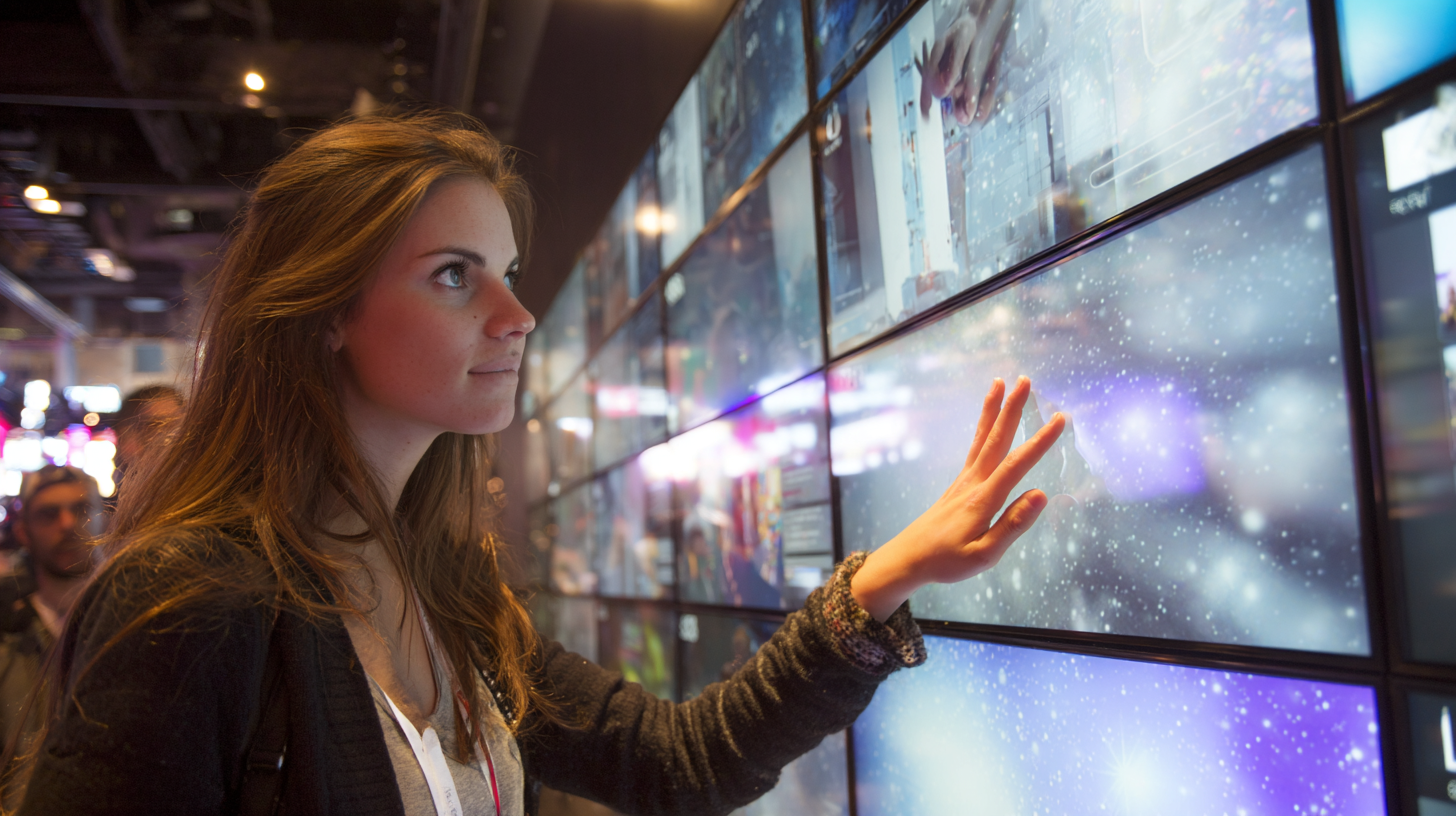Digital Signage 55 vs Traditional Displays An In-depth Analysis of Efficiency and Impact
Table of Contents
- Comparing Engagement Metrics: Digital Signage vs Traditional Displays
- Cost-Benefit Analysis: Long-term Savings of Digital Signage
- Impact on Consumer Behavior: Statistics Supporting Digital Signage Effectiveness
- Technological Advancements: How Digital Signage Outpaces Traditional Displays
- Environmental Considerations: Sustainability of Digital Solutions vs Traditional Methods
- FAQS
- Conclusion
- Related Posts
In today's rapidly evolving technological landscape, businesses are increasingly turning to Digital Signage 55 to enhance communication and engagement. Research indicates that digital signage can improve audience engagement by up to 47.7% compared to traditional displays, making it a pivotal tool in effective marketing strategies. Ledersun Technology Co., Ltd., as a dedicated LCD display technology application supplier, recognizes the profound advantages that come with implementing such interactive solutions, particularly in educational settings and commercial advertising. With the ability to easily update content in real-time, Digital Signage 55 not only captures attention but also drives higher returns on investment through increased customer engagement and improved message retention. As more organizations strive to modernize their display systems, the comparison between Digital Signage 55 and traditional displays becomes crucial, highlighting efficiency and impact as key differentiators in today's competitive market.

Comparing Engagement Metrics: Digital Signage vs Traditional Displays
 Digital signage has rapidly gained traction over traditional displays, primarily due to its ability to engage audiences more effectively. When examining engagement metrics, digital signage often outperforms static displays in delivering vivid, dynamic content that captures attention. For instance, studies indicate that digital signage can increase audience interaction by up to 400%, thanks to the integration of multimedia elements—videos, animations, and real-time updates—that draw viewers in.
Digital signage has rapidly gained traction over traditional displays, primarily due to its ability to engage audiences more effectively. When examining engagement metrics, digital signage often outperforms static displays in delivering vivid, dynamic content that captures attention. For instance, studies indicate that digital signage can increase audience interaction by up to 400%, thanks to the integration of multimedia elements—videos, animations, and real-time updates—that draw viewers in.
Tip: To maximize engagement, consider the content you display. Use concise messaging complemented by eye-catching visuals. Incorporating interactive elements like QR codes or touchscreens can further encourage viewer participation and feedback.
Traditional displays have their own merits, often serving as reliable, low-cost options for specific environments. However, their fixed nature limits their ability to adapt to changing audience needs or integrate recent information. In contrast, digital signage allows for content that can evolve with every viewing, ensuring that audiences remain informed and intrigued.
Tip: Regularly update your digital signage content and criteria for success. Track metrics like dwell time and viewer interactions to refine your strategy over time. This iterative approach ensures that your displays remain relevant and impactful.
Cost-Benefit Analysis: Long-term Savings of Digital Signage
When evaluating the cost-benefit of digital signage versus traditional displays, it's essential to consider the long-term savings that digital solutions can bring. While the initial investment for digital signage may be higher, the reduced costs in printing, labor, and maintenance can lead to significant savings over time. Digital displays allow for dynamic content updates, which means businesses can easily promote current events, special offers, or important announcements without the need for new materials.
**Tip:** To maximize your investment in digital signage, consider utilizing cloud-based software that allows for easy content management. This ensures that updates can be made remotely, reducing the need for on-site staff and saving time.
Furthermore, the energy efficiency of digital displays can contribute to long-term savings. Many modern digital signs are designed to consume less power while still delivering high-quality visuals. By adopting energy-efficient models, businesses can significantly lower their utility bills.
**Tip:** When selecting equipment, look for Energy Star certified models, as they are tested to ensure they meet energy efficiency guidelines, leading to lower overall operational costs.
Digital Signage 55 vs Traditional Displays: An In-depth Analysis of Efficiency and Impact
| Attribute | Digital Signage 55 | Traditional Displays |
|---|---|---|
| Initial Cost | $2,500 | $1,200 |
| Annual Maintenance Cost | $300 | $100 |
| Average Lifespan (Years) | 7 | 5 |
| Energy Consumption (Watts) | 200 | 150 |
| Content Update Frequency | Daily | Monthly |
| Customer Engagement Impact (%) | 30 | 10 |
| Return on Investment (Years) | 3 | 4 |
Impact on Consumer Behavior: Statistics Supporting Digital Signage Effectiveness
Digital signage is rapidly transforming the way brands engage with consumers, proving to be significantly more effective than traditional displays. According to a report from the Digital Signage Federation, digital signage can increase brand awareness by up to 47.7%, largely due to its ability to attract attention with dynamic content. In fact, studies show that 83% of consumers are more likely to interact with a digital display than a static one, highlighting the interactive potential of modern technology in promoting products and services.
Moreover, the effectiveness of digital signage in influencing consumer behavior is further underscored by a Nielsen report, which found that 70% of shoppers indicated that digital displays influenced their purchasing decisions. The engaging nature of moving visuals and targeted messaging has proven to enhance the shopping experience, leading to increased dwell time and ultimately boosting sales. Additionally, brands that utilize digital signage report an average increase in sales of over 10%, demonstrating the tangible impact this medium can have on retail environments.
As businesses continue to leverage these statistics, the shift towards digital signage is not just a trend but a strategic move to enhance consumer engagement and drive revenue.
Technological Advancements: How Digital Signage Outpaces Traditional Displays
In recent years, the emergence of digital signage has revolutionized the way businesses communicate with their audiences. Unlike traditional displays, which typically offer static messages, digital signage harnesses advanced technologies to deliver dynamic content that can be easily updated in real-time. This adaptability allows businesses to engage customers more effectively, tailoring messages and promotions based on current trends and customer behavior, ultimately enhancing the overall user experience.
Furthermore, technological advancements in digital signage have significantly improved efficiency. High-resolution displays, interactive screens, and user-friendly content management systems enable organizations to manage their messaging with greater ease and precision. These innovations not only streamline the process of content creation and distribution but also facilitate analytics and monitoring, providing valuable insights into audience engagement. As a result, companies can maximize their advertising impact while minimizing operational costs, positioning digital signage as a vital asset in modern marketing strategies.
Efficiency Comparison: Digital Signage vs Traditional Displays
Environmental Considerations: Sustainability of Digital Solutions vs Traditional Methods
The environmental impact of digital signage compared to traditional displays is a topic of increasing significance as businesses aim for sustainability. According to a report by Smithers Pira, the digital signage market is projected to grow to $29.8 billion by 2024, emphasizing the shift towards more dynamic and efficient technologies. Digital displays can significantly reduce paper waste, which is a crucial benefit; for instance, a single digital sign can replace thousands of printed materials over its lifetime. This shift not only cuts down on materials consumed but also lessens the carbon footprint associated with paper production and disposal.

Moreover, energy consumption is a critical consideration in this debate. A study from the Global Display Industry Initiative indicates that newer LED and OLED digital signage technologies are becoming increasingly energy-efficient, using up to 60% less energy than traditional backlit displays. While the initial investment for digital signage may be higher, the long-term savings in terms of energy costs and reduced environmental impact are substantial. These factors underline the importance of considering environmental sustainability when choosing between digital and traditional display methods.
FAQS
: Digital signage offers the ability to deliver vivid, dynamic content that can significantly increase audience interaction, with studies showing up to a 400% increase compared to traditional displays.
Businesses should use concise messaging paired with eye-catching visuals and incorporate interactive elements like QR codes or touchscreens to encourage viewer participation and feedback.
Traditional displays are fixed and cannot adapt to changing audience needs or integrate recent information, making them less effective in engaging viewers over time.
Regular updates ensure that digital signage remains relevant and impactful, helping to maintain audience interest and encourage engagement.
Advances such as high-resolution displays and user-friendly content management systems enhance the efficiency of digital signage, allowing for real-time updates and better audience engagement analytics.
Tracking metrics like dwell time and viewer interactions allows businesses to refine their digital signage strategy, making the content more aligned with audience preferences and improving engagement.
Digital signage offers a more engaging user experience through dynamic content and real-time updates, while traditional displays provide a more static and less adaptive experience.
Digital signage streamlines content creation and distribution processes, minimizes operational costs, and maximizes advertising impact, making it a vital asset for modern marketing strategies.
Yes, digital signage can tailor messages and promotions based on current trends and customer behavior, enhancing engagement and user experience.
Content that is concise, visually appealing, and includes interactive elements tends to work best for engaging audiences through digital signage.
Conclusion
In the rapidly evolving world of visual communication, "Digital Signage 55" stands out as a superior alternative to traditional displays. By comparing key engagement metrics, it's evident that digital signage captures attention more effectively, leading to higher consumer interaction. Additionally, a cost-benefit analysis reveals that while the initial investment in digital solutions might be higher, the long-term savings associated with reduced maintenance and content updates make it a viable option for businesses.
Moreover, statistics support the claim that digital signage significantly impacts consumer behavior, enhancing brand recognition and driving sales. With continuous technological advancements, digital signage solutions consistently outpace traditional methods in functionality and adaptability. Lastly, from an environmental perspective, digital signage offers sustainable advantages, reducing paper waste and energy consumption. Ledersun Technology Co., Ltd. is at the forefront of this revolution, providing advanced digital signage solutions that elevate educational and commercial environments globally.
Related Posts
-

Proudly Made in China The Global Excellence of Best Digital Sign Systems
-

Quality Products from China Leading Global Digital Signage Advertising Industry
-

Top Digital Solutions for Interactive Kiosks That Transform User Engagement
-

What Makes the Best Digital Ad Screen Ideal for Global Buyers
-

Revolutionizing Digital Signage and Interactive Kiosks Trends to Watch in 2025
-

The Ultimate Guide to Choosing the Best Digital Display Kiosk for Your Business
Blog Tags:





